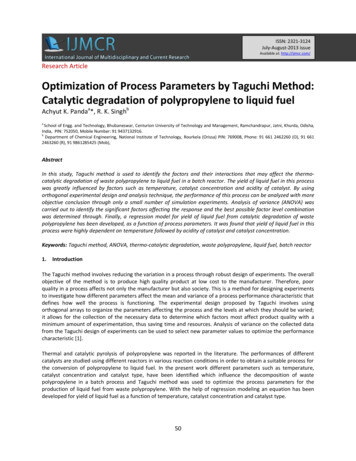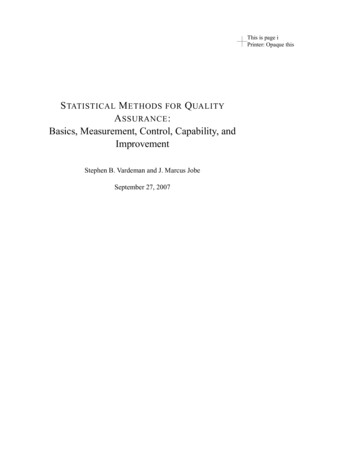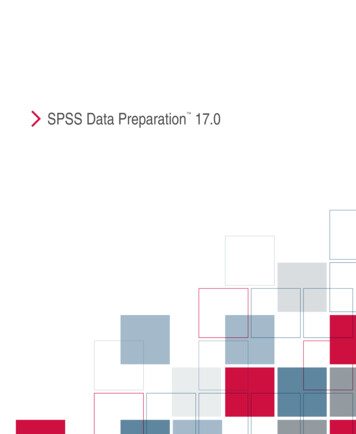
Transcription
The Book ofStatisticalProcessControlSecond EditionThe Zontec PressCincinnatiComplimentary Zontec eBook www.zontec-spc.com
Copyright 2002-2010 Zontec Inc. All rights reserved No part of thispublication may be reproduced, stored in a retrieval system or transmitted inany form or by any means electronic, mechanical, photocopying, recording orotherwise, without the prior written permission of the publisher.Published byThe Zontec Press1389 Kemper Meadow DriveCincinnati, OH 45240www.zontec-spc.comThe sponsoring editor for this book was Warren T. Ha; the editing supervisor and production manager was Richard K. Morris. Cover art productionby Jean Green, Toledo, Ohio.Many of the charts in this publication were created with Zontec's Synergy2000 and Synergy 3000 statistical process control software.Library of Congress Control Number: 2002105114Printed in the USASecond Edition
We dedicate this book to our customerswho have contributed to our success in the software industryand supported us across more thantwo-and-a-half decades of computer technologyadvancements.
R
ContentsContents1.0 Introduction to SPC 31.141.151.16Why SPC? . 1Mass production and the need for standardization . 1What is quality? . 5Variation . 8Statistical thinking vs. Engineering thinking . 9Development of Shewart control charts . 10Prevention vs. detection as quality control . 10Definition of a process . 10Who is the customer? . 11Determining loss . 12Common causes vs. special causes . 13What to control? . 13Human elements of SPC programs . 14Management's responsibilities . 16Team approach to problem solving . 16Negative effects of specs and work quotas . 172.0 Statistical distributions2.12.22.32.42.52.62.72.82.9Why do we need statistics? . 19Populations . 20Probability . 20Statistical symbols . 20Measures of central tendency . 22Measures of process dispersion . 25Some common distributions . 27Properties of the normal curve . 29Central limit theorem . 303.0 Data collection & recording3.13.23.33.4Types of data . 33Characteristics . 34Collecting data . 35Recording data . 39Complimentary Zontec eBook www.zontec-spc.com
The Book of Statistical Process Control4.0 Problem-solving techniques4.14.24.34.44.54.6Pareto analysis . 45Brainstorming . 49Cause-and-effect diagrams . 51Scatter diagrams . 53Histograms . 54Run charts . 595.0 General concepts of control charting5.15.25.35.45.55.6The meaning of limits . 61Two modes of change in a process: average & dispersion . 64Prediction: The key to timely detection of changes . 65Variation within and between samples . 67Trial limits, control limits and recalculation points . 68The concept of continuous improvement . 686.0 Control charts for variable data6.16.26.36.4X-bar & R charts . 71Median charts . 80s charts . 83Using sample variation to determine process variation . 867.0 Process capability studies7.17.27.37.47.5Natural tolerance vs. engineering tolerance . 87Calculating the percent out of spec . 88Impact of non-normal distributions . 89Common capability and performance indexes . 90Six-Sigma quality . 938.0 Control chart analysis8.18.28.38.48.58.68.78.88.9Detecting patterns . 95Cycles . 97Trends . 97Mixtures . 98Stratification . 98Shifts . 99Instability . 99Bunching . 100Freaks .100Zontec copyrighted material www.zontec-spc.com
Contents9.0 Measurement errors9.19.29.39.49.5Accuracy, precision and predictability . 103Operator variability . 104Instructions . 105Manual inspection problems . 106Repeatability & Reproducibility .10710.0 Control charts for non-conforming attributes10.1 Types of attribute data and charts .11510.2 p charts .11610.3 np charts .11911.0 Control charts for the number of non-conformities11.111.211.311.4c charts .123u charts .126Demerit systems . 128Plotting defects by type . 12912.0 Special charts for special applications12.1 Short run SPC . 13112.2 Toolwear charts . 13812.3 Three charts . 14213.0 Automating data collection and deploying SPC globally13.113.213.313.413.513.613.713.8Automating data entry .145Hardware-dependent-vs. flexible systems . 146Networked SPC . 146Interoperability with external systems . 147Multi-plant implementations . 148Supply chain SPC . 148Choosing a system .149Bringing your program on-line . 15014.0 Getting started14.114.214.314.414.514.6Education . 151Making the transition to SPC .152The production worker's role in SPC . 153Management's role . 153Start slowly . 154The next step . 155Complimentary Zontec eBook www.zontec-spc.com
The Book of Statistical Process ControlReferences & bibliography . 157Common symbols . 159Glossary . 161AppendicesAppendix A:Appendix B:Appendix C:Appendix D:SPC formulae .174χ2 values for confidence intervals .182Table of constants for control charts .184Z scores (percent out of spec) .187Index . 189Zontec copyrighted material www.zontec-spc.com
ContentsComplimentary Zontec eBook www.zontec-spc.com
The Book of Statistical Process ControlZontec copyrighted material www.zontec-spc.com
ForewordIt is only logical that a book to educate readers about the basics ofstatistical process control (SPC) should come from a company likeZontec, since the company's initial focus was on training and consulting—not software development. Over the years, we've observed thattoo many companies are looking for quick fixes and shortcuts toquality. Unfortunately, there is no such thing. Any company whosequality program hinges on this philosophy is surely doomed to failure. For without a thorough understanding of the basics, processimprovement is virtually impossible.On the other hand, workers do not have to be statisticians to takeadvantage of SPC. That is the reason for this book: to provide apractical, common-sense explanation of the underlying principles ofstatistical process control. The topics included in this book have beenbased on more than 25 years of exposure to the customer side ofquality assurance. Readers should not find the techniques and calculations described in this publication intimidating. Today's SPCsoftware programs were designed to plug in the correct formulas andperform the number crunching for you so instead you can spend yourtime effectively managing the process. Concentrate on understandingthe situations presented here, and reach for the formulas on those rareoccasions that you need to know how the data was derived.Finally, Zontec has long maintained that quality is not just a functionof the Quality Department. Everyone shares a stake in his or herorganization's quality. By working as a team, quality becomes thenatural way of doing business.Here's to the process!Richard K. MorrisComplimentary Zontec eBook www.zontec-spc.com
The Book of Statistical Process ControlZontec copyrighted material www.zontec-spc.com
Introduction to SPC thinking11.0 Introduction to SPC thinkingBy a small sample we may judge the whole piece.Miguel De Cervantes1.1 Why SPC?Success in the global market depends on quality. Companies thatproduce high quality consistently will succeed; those who do not willultimately fail.The emphasis here is on consistent high quality. It isn’t enough toproduce quality sporadically; one bad product can hurt a company’sfuture sales. Inconsistent quality is also more expensive since badparts have to be reworked or even scrapped. On the other hand, whenquality improves productivity improves, costs drop, and sales go up.Companies don’t design poor quality; it is usually the result of avariation in some stage of production. Therefore, product qualitydepends on the ability to control the production process. This iswhere statistical process control, SPC, comes in. SPC uses statisticsto detect variations in the process so they can be controlled.This book offers a detailed look at SPC, from how and why it beganto how it works. It also offers ways to start up an SPC program, anddescribes how to automate SPC.1.2 Mass production and the needfor standardizationBefore the arrival of mass production, craftsmen managed everyaspect of their products. They designed an item, produced its parts,and assembled them. They personally marketed their products anddealt directly with their customers.Complimentary Zontec eBook www.zontec-spc.com
2The Book of Statistical Process ControlIf a problem came up, the craftsman could alter the product toprevent its recurrence or lose those customers who were unhappywith it. They had to balance the cost of production, the ease ofsubsequent operations, and customer standards as they saw fit. Thus,they had a good understanding of the overall picture.This began to change in the late 1700’s, when the United States had ashortage of skilled craftsmen and a need for a large quantity ofmuskets. Eli Whitney believed he could mass produce muskets, usingmachines to make parts that would be interchangeable with spares.These machines could be run by ordinary men, not skilled craftsmen.The government gave him a contract and funds, and he began todesign and build the machines needed to make each part.He recognized that if he relied on one machine, one small part out oforder could make the whole machine useless. To avoid this, hedeveloped separate processes for each part and designed a machinefor each process. That way if an experiment showed one processfault, he could adopt another machine without changing the method.Along with the machines, he invented tools, gages, jigs, and fixturesso all the parts would be close to dimensional tolerances. He alsotrained his workers on how to use them.When he did not deliver the muskets on time, some in the governmentquestioned his methods and his ability to fulfill his contract. Heresponded by letting a group of his skeptics assemble muskets from atrunk of parts, using only screws and screwdrivers. They saw that theweapons could be assembled without the normal fitting and filing andgranted him an extension. Although it took several years longer thanhe expected to deliver the first 10,000 muskets, he succeeded indeveloping a way to mass produce them.Whitney succeeded because he knew that variation existed, and headjusted his process to compensate for it. He knew that for massproduction to work, his machines had to standardize the parts so theywould be interchangeable. He knew that to be interchangeable eachpart had to fit the assembly without filing. This is why he developedgages representing the part the product had to fit.Zontec copyrighted material www.zontec-spc.com
Introduction to SPC thinking3Gages were a key to standardizing parts and craftsmen began to usethem to judge their products. Now, instead of adjusting each part tofit a unique assembly, they adjusted parts to fit the gage. Thisremoved them from the needs of the end user. The buyers had to"specify" their requirements, and craftsmen shifted their focus fromthe product’s function to the customer’s specifications. They nolonger understood the big picture.It was up to the customer to define user requirements, and theproducers fought for the widest tolerances they could get. Withsuppliers trying to coax wider tolerances out of customers andcustomers trying to narrow them, producers focused on taking themaximum advantage of specifications. This shifted the focus awayfrom quality and led to the idea that defective parts can’t be avoided.Rather than looking for ways to reduce defects, both producers andconsumers accepted them as a natural part of mass production. Withonly a few producers, consumers often had the choice of poor qualityor nothing at all.During World War II, the U.S. Government classified qualitycontrol as top secret and required all military suppliers to use controlcharts. When the war ended, the government relaxed its requirementsand suppliers dropped the charts with other “red tape.” They failed torecognize the power of statistical tools in predicting and controllingproduction processes. With the soaring demand for products, supplierefforts focused on how many instead of how good. There was littlereason to improve quality.However, in Japan it was a different story. Between 1945 and 1949,the Civil Communications Section of the Allied command upgradedthe work practices of the Japanese by establishing quality standardsand techniques. The Japanese had been inspecting for quality andknew their products lacked it. They also knew this inspection did notmake their products any better. They began using statistics to controlquality at the point of production and within a few decades becameknown as one of the highest quality producers in the world. Theturning point for the Japanese was when they shifted from detectingpoor quality to preventing poor quality.Complimentary Zontec eBook www.zontec-spc.com
4The Book of Statistical Process ControlThe U.S. was forced to rethink its smug attitude toward quality whencompetition increased in the global market. With more selection,consumers could demand better quality. To stay competitive, producers had to shift their attention back to quality and they began workingto continuously improve their products.By the late 1970's, a number of overlapping and sometimes conflicting national quality system requirements emphasized the need formore uniform international guidelines. Within 10 years, the International Standards Organization (ISO), a worldwide federation representing nearly 100 countries, published the ISO 9000 StandardSeries.In general, ISO 9000 focuses the world's manufacturers on anagreed-upon level of quality in the delivery of goods and services.Certification to ISO 9000 indicates that a company understands,documents, implements and demonstrates the effectiveness of ISOdefined quality practices. Conformance with ISO 9000 is frequently arequirement in business-to-business purchasing transactions.ISO 9000 guidelines are very generic allowing users wide latitude inhow they establish their individual quality systems. SPC can be apowerful tool in achieving ISO 9000 certification by leading the wayto observable process and quality improvement. On average, companies spend between three to nine months learning the standardrequirements, training its personnel, developing and implementingcompliant systems and monitoring their results.Many industrial sectors have since realized the necessity to supplement the ISO quality system model with a set of requirements thatsatisfy internal, governmental, regulatory and global standards thatapply only to them. The first of these was Quality System Requirements QS-9000 for the U.S. auto industry, issued in 1994. A moreglobally focused standard, ISO/TS 16949 now applies to automotivemanufacturers worldwide.Other supplemental industrial standards to ISO 9000 include ISO9100 for aerospace suppliers, ISO 13485 for medical device manufacturers, and TL 9000 for the telecommunications industry.Zontec copyrighted material www.zontec-spc.com
Introduction to SPC thinking5Though not a quality standard in the terms of ISO, a number of themajor industrial nations have established awards programs forenterprises within their borders that are judged as the very best inquality. One of the most notable is the Malcolm Baldrige NationalQuality Award in the U.S., named for the late Secretary of Commerce whose managerial excellence contributed to long-term improvement and efficiency and effectiveness of the U.S. government.Given annually, the Malcolm Baldrige Award bolsters the concept ofquality improvement to small companies as well as large, to serviceindustries as well as manufacturing and to the public sector as wellas private enterprise.1.3 What is quality?Before we can control quality, we need to understand what the word“quality” means. Quality, like beauty, is in the eye of the beholder.Each of us judges the quality of many items every day, and we eachhave a different idea about what quality is for each item. We knowwhat we like or what we want, and what we don’t like or want. Howwe determine the quality of an item depends on both our personalpreference and our frame of reference for that particular item.For example, production workers might see quality as conformanceto specifications. If the size of the hole they produce is within theirtolerance, it is a good hole. If not, it’s bad.Marketing people might think of quality as something that sells welland causes little trouble for the customer.Supervisors see quality when production is higher than normal andthere are few reworks.Customers see quality if the product does what they expect it to dowithout any breakdowns.Complimentary Zontec eBook www.zontec-spc.com
6The Book of Statistical Process ControlQuality is conformance to specification.This idea comes from labeling parts that are in-spec as good and outof-spec as bad. Are they really good and bad? No. Somebody haseither assigned or negotiated the tolerances and a simple stroke of apen changing these tolerances can transform bad products into good.Quality is a measure of how good a product is — quality ismeeting customer acceptable quality levels. Does the quality of theproduct change when you renegotiate the contract with the customer?No, acceptable quality levels are simply tolerances on tolerances.They specify the number of times it is permissible to miss the targetby a given amount.Quality is zero defects.This notion is based on our ability to define a defect. If we define adefect as a part out of spec, then we are right back at “conforming tothe specifications.”Quality is the absence of variation.This is a goal that initially sets many companies' SPC implementations in motion.Quality is in the eyes of the beholder.With manufactured products, quality is determined by the customer.If the customer thinks the quality is good, then it’s good. In makingthe judgment the customer weighs competitive products, cost, performance, and personal preference.Because we define a product’s quality in relation to competingproducts, it is a constantly moving target. Finding this target meansadjusting to meet the customer’s needs as well as maintaining thecompetitive edge. This requires never-ending improvement.Quality can be broken down into three areas of concern to thecustomer:1) Design Quality2) Manufacturing Quality3) Performance Quality or ReliabilityZontec copyrighted material www.zontec-spc.com
Introduction to SPC thinkingCompany A7Company BFigure 1.1Distributions of output from two companies. All of Company A's product fallswithin specification limits. Company B's production is centered at thedesigned optimum, but does produce some out-of-spec parts.Design Quality is the intended shape, size, color and function of theproduct. The designer must assess the needs of the customer andselect characteristic values that will create the greatest customersatisfaction. Product quality can never be better than the quality ofthe design.Manufacturing Quality is how well the product meets the design. Itis this type of quality that is the subject of this book. The better themanufacturing quality is, the better the product quality will be. Andif this type of quality is good, product quality will be more consistent. Keep in mind, however, that while improving manufacturingwill improve a product to a certain extent, it will never improve apoor design.Performance Quality is a measure of how dependable a product is.The level of this type of quality is affected by how often a productfails, the time between failures, the time it takes to repair, andrepair costs.Most customers don’t tell the manufacturer what they want directly.They tell them by buying or not buying. To stay competitive, acompany must consider how their customers look at quality. Fromthe customer’s point of view, quality includes the marketing, engineering, manufacturing, and maintenance through which the productor service meets their expectations.Complimentary Zontec eBook www.zontec-spc.com
8The Book of Statistical Process ControlFigure 1.1 illustrates the output of two companies making the samepart. Company A has much tighter control over the dimension buttheir process is centered near the low limit. Company B, however,doesn’t have enough control to keep their products within spec all thetime and produces a 3% out-of-spec product.From a producer’s point of view, Company A would appear to be thebetter company. The tighter control of the dimensions reduces thecost of materials.A customer who is only buying one or two items would preferCompany B’s product. Why? Company B produces an average of68% of their product in the middle third of the tolerance. Andchances are many of Company B’s parts will be exactly on target —a perfect product. Company A’s products run towards the low end ofthe limits, which means there is a slight chance of getting a perfectproduct and a good chance of getting an inferior one.If Company A can center their process on the design target, they willhave the better product. Centering a process is usually easier thanreducing process variations. This is why controlling variables is thebiggest problem in quality production.1.4 VariationIf it was possible to make all items alike, we would not need tolerances. Since no two things are exactly alike, we must make allowances for the differences. Tolerances are these allowances. Theyprovide a range over which a product can vary and still be acceptedby the customer.Of course, “accepted” is not “desired,” and in the battle over width oftolerances the idea of a specific target has been lost. For example,ask almost any machinist what size a part is supposed to be, and youwill get a range for an answer — “from 2.048 to 2.052 inches.” Whyisn’t the answer “2.050 inches” if that is the target? Because withtolerances, we tend to aim for the acceptable range instead of theZontec copyrighted material www.zontec-spc.com
Introduction to SPC thinking9exact target. This means we are less likely to hit the target. It alsomeans our variance will most likely be greater than if we aimed forthe target.Variance is a natural occurrence, but that doesn’t mean we shouldn’ttry to control it. If we aim for a specific target value, instead of arange, we have more control of the variance. In archery, if you shootfor a bull's eye, your arrow is likely to land near it, but if youbroaden your aim to encompass the entire target, your arrow couldland anywhere. The same is true for manufacturing.A perfect product is one that is on target, so aiming for the target willimprove product quality. Specifying a target value and controllingthe variability makes more sense than focusing on tolerances.1.5 Statistical thinking vs. Engineering thinkingEngineers have it made. In the world of engineering, two plus twoalways equals four. When products are designed the dimensions areexact, the calculations are accurate, and the resulting characteristicsare known.Manufacturing is not so precise. Variations can occur anywhere inthe process and are often hard to predict accurately. People workwith items that were intended to be two inches long, but in realitythey are anywhere from an eighth of an inch too big to an eighth ofan inch too small. Two plus two seldom equals four.This has frustrated managers worldwide for a long time. Engineerspredict the output of a process and we wonder why things didn’t turnout as planned. The problem is in the definition of what should be.Statisticians addressed this problem by developing methods forcalculating expected results which take variation into account. Theirmethods call for observing the process in its actual environment sothe expected variability can be measured.Complimentary Zontec eBook www.zontec-spc.com
10The Book of Statistical Process Control1.6 Development of Shewhart control chartsIn the 1930’s, Walter Shewhart devised a way to predict what couldhappen during a production process. His technique involved collecting observations from the shop floor, running calculations on thisdata and then plotting it on a graph. Based on statistics of what hadhappened in the process, he could predict what would happen in thefuture. Comparing the actual result to his prediction was a simplematter of plotting points on graph paper. His graphs became knownas the Shewhart Control Charts. They were and are used to controlthe output of manufacturing processes.1.7 Prevention vs. detection as quality controlEstimates show that it is ten times more costly to correct a problemthan it is to prevent it. With this kind of savings, companies canreduce prices, expand their R&D, and increase profits at the sametime.Changes to a product’s characteristics are merely a reflection ofchanges in i
where statistical process control, SPC, comes in. SPC uses statistics to detect variations in the process so they can be controlled. This book offers a detailed look at SPC, from how and why it began to how it works. It also offers ways to start up an SPC program, and describes how










